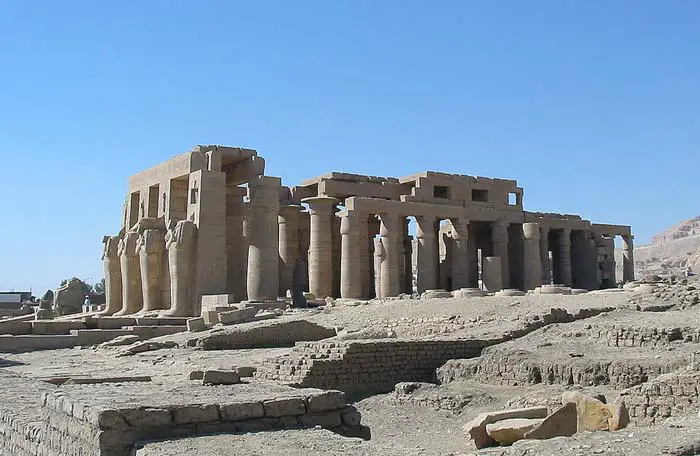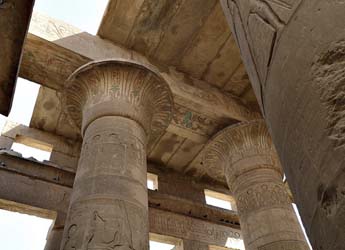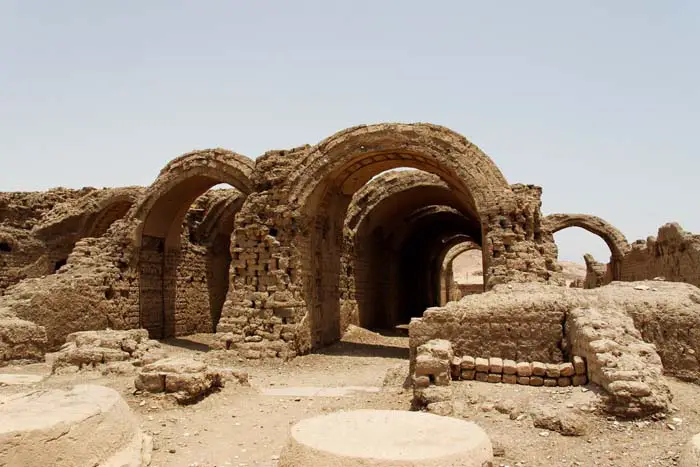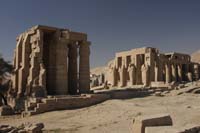The Ramesseum
The last great pharaoh of Egypt, Ramesses II, spent 20 years building the Ramesseum during his unusually long 67 year reign. Ramesses II ruled during the height of Ancient Egyptian power and glory during the 13th century BC from 1279-1213 BC. The king’s incredible wealth, popularity and vanity led to one of the largest and most grandiose of mortuary temples.
Location
The Ramesseum is located in the Theban Necropolis, a popular area for mortuary temples for Pharaohs in the New Kingdom. The Theban Necropolis is located in Upper Egypt and stands across the Nile from the modern day city of Luxor. It is dedicated to the memory of Ramesses II and to the God Amon Ra.
Tomb of Osymandias
Over the years, The Ramesseum has been referred to by many names including “Tomb of Osymandias”, “The Temple of Millions of Years United with Thebes,” and “Memnonium”. French scholar Jean-François Champollion was the first to identify the ruins as belonging to Ramesses II and coined the name, “The Ramesseum” back in 1829.
Design
Adhering to standard criterion of New Kingdom temple architecture, The Ramesseum measures 600 feet (183m) by 220 feet (67m), which is unusually large. Today, the temple is in ruins but visitors are still able to enjoy the hands from the enormous 57 foot (17m) high statue of Ramesses II which once stood in front of the very first pylon to the temple. It probably weighed at least 1,000 tons. At the base it reads: “My name is Ozymandias, King of Kings: Look upon my works, ye Mighty, and despair.”

© Crowcombe Al - The Ramesseum, at Luxor
The main entrance stood at the eastern situated pylon and was decorated with reliefs of scenes from the Battle of Kadesh, the Festival of Min and the Syrian Wars. On the right wing of the pylon are depictions of the cities that Ramesses II conquered during his popular reign, as well as depictions of prisoners being taken to the King. The left wing of the pylon reflects the famous battle between Ramesses II and the Hittites. In the first courtyard, only one colonnade remains.
The Ramesseum houses a Hypostyle hall which is a grand interior space where pillars and columns hold up the roof. Presently, 29 columns still stand in the Ramesseum’s Hypostyle hall. To allow in light, the middle columns are shorter than the outer edge columns. It also featured traceried windows. Depicted on the columns are additional scenes of the Battle of Kadesh.

© Daniel & Kate - Ramesseum Hypostyle Hall Columns
Two rows of Osiris columns represent Ramesses II in the second courtyard, where the best preserved statues can be found. This courtyard is in far better condition than the first. Situated to the south of this second courtyard is a second but smaller Hypostyle hall that at one time boasted eight papyrus-bud columns. Also called the Astronomy Hall, the very first 12-month calendar is illustrated here. On the western wall is a scene depicting Ramesses II getting his name recorded on the tree of life by the God Thoth and the Goddess Seshat, to ensure a long, everlasting life.
To the west lay two vestibules that are today in ruin. These vestibules lead to a library and a linen room and what was once a sanctuary dedicated to Amon Ra. It was here that Ramesses II built a mud break palace where he stayed during visits to his mortuary temple.
Display of Great Wealth
Aside from its enormous size and the 57 foot high statue of Ramesses II, the Ramesseum also contained the earliest arches in history. These arches were barrel shaped and used for storing funerary materials, worker possessions and were enormous storerooms of grain and corn. In ancient Egypt, grain was considered like gold and an abundance of it was stored in these granaries with arches. This grain was shipped around the country and it is also speculated that the larger temples like the Ramesseum had their own merchant ships outfitted with traders. These granaries served as lavish representations of the Pharaoh’s great wealth.

© NeferTiyi - Granaries at the Ramesseum
The Ramesseum Quick Facts
- Funerary or mortuary temple of Ramesses II who reigned between 1279-1213 BC.
- Constructed on the western bank of the Nile River in ancient Thebes in Upper Egypt.
- Famous for the 57 foot high statue of Ramesses II which now sits in ruins with only fragments left behind. This enormous statue was transported 170 miles over land to the Ramesseum.
- Scenes and reliefs inside the temple include the Battle of Kadesh, Siege of Dapur and Tunip, Ramesses II being crowned by Sekhmet, Amon-Ra and Khonsu, Barques procession, and litanies to Ptah and Ra-Harakty.
- A temple dedicated to Ramesses II’s mother, Tuya, and his beloved chief wife, Nefertari stands to the north of the Hypostyle hall.

